Analysis of the optical elements of a periscope
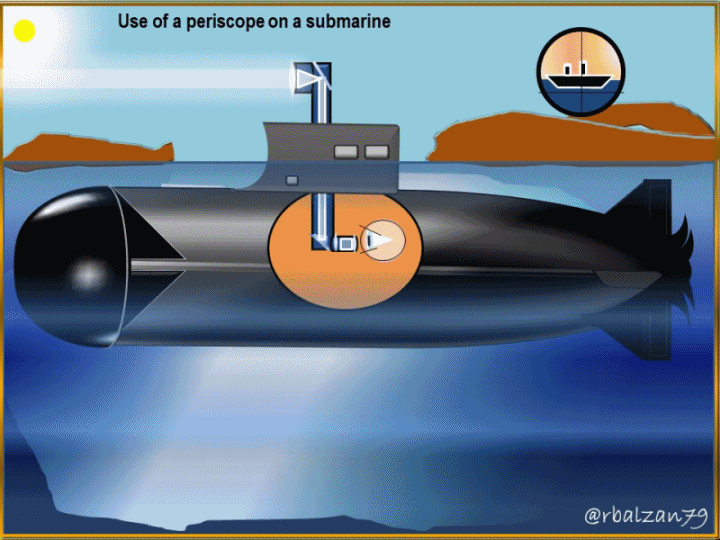
1.- Analysis and calculations of variables in the generation of images in a convergent lens.
2.- Calculations of variables in image generation in a diverging lens.
4.- Converging-converging lens arrangement in the optical system of a refracting telescope.
5.- Geometry implemented in the understanding of the algebraic formulation of thin lenses.
6.- Analysis of the arrangement of the optical system of a Newtonian reflecting telescope.
7.- Analysis of the arrangement of the optical system of a Newtonian reflecting telescope.
8.- Analysis of the optical elements of a Sextant.
9.- Analysis of the optical elements of a Porro binoculars.
So far we have analyzed the optical system of wonderful instruments such as the refracting and reflecting telescope, sextant and Porro binoculars, in this opportunity, our purpose is the analysis of the optical elements of a periscope, which, like the previous optical instruments, implements the luminous rays to carry any image observed through this instrument to our retinas and then arrive through the optic nerve to our brain.
Initially we can say that this optical instrument is used to be able to observe from a hidden or difficult to see position and they can be constituted by simple optical systems, for example, only two flat mirrors, i.e., a cylindrical billet with a pair of mirrors at its ends, The objective mirror should be placed at 45° degrees with respect to the horizontal and the ocular mirror parallel to it, i.e. also at 45°, as shown in figure 1 below.
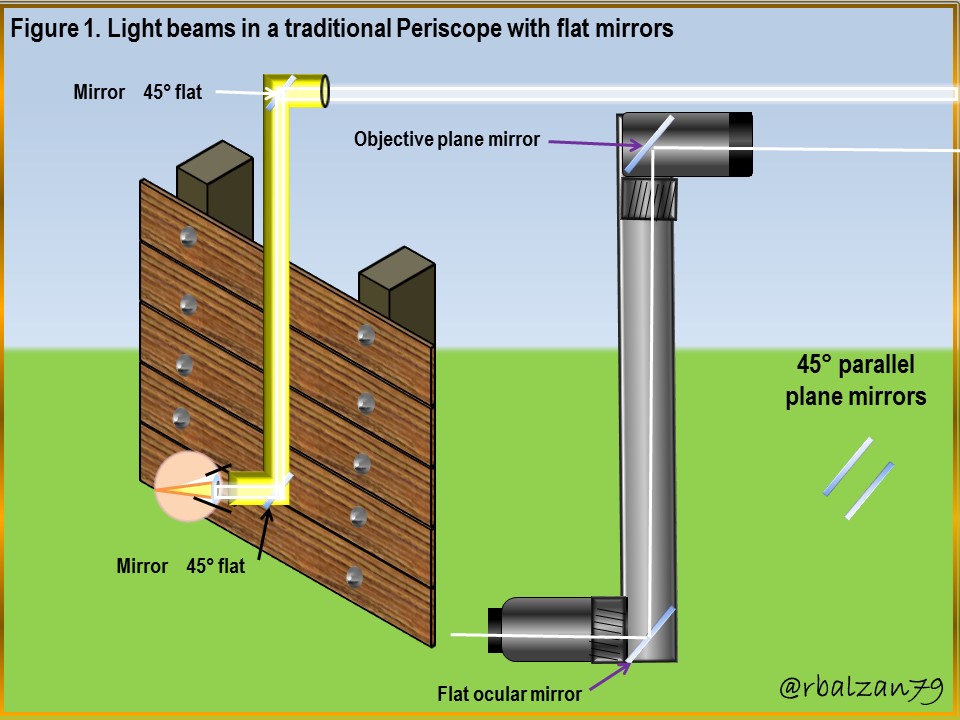
In the previous figure 1, we were able to observe the incident and reflected light rays in the two flat mirrors at 45° each and, in this way, bring to our retinas the image observed from a hidden place, this, only with the implementation of two flat mirrors, these flat mirrors can be replaced by a pair of prisms and, inside these optical elements (prisms), a total internal reflection can be carried out, as you can see in the following figure 2.
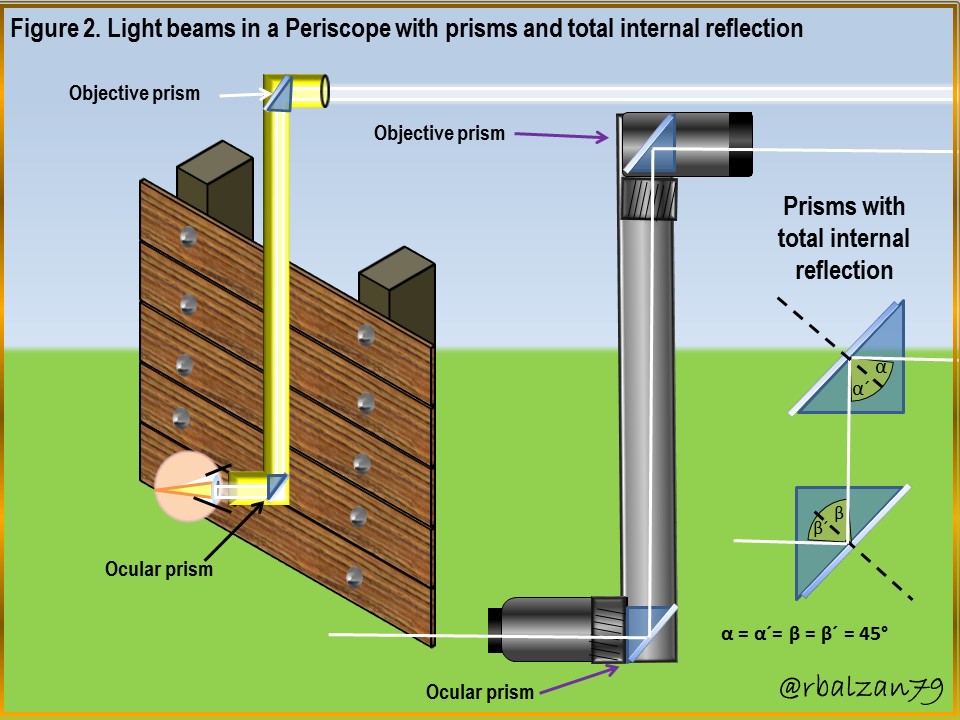
From the previous figure 2, we can express that the prisms have the characteristic of being able to scatter white or visible light by refracting it, but can also make the light is not refracted, but that is reflected internally total, for this, as we saw in the last article, the angle of incidence of the light beam must be greater than the angle limit or critical and, when we relate the two refractive indices of the related media (glass and air), we obtain that the critical angle is 41.8° approximately 42°, therefore, when the light ray hits the surface of a prism and, when doing so with an angle greater than 41.8°, then, a total internal reflection is generated, as you can see, the angles of incidence and reflection are equal to 45°, that is, greater than the limit or critical angle.
It is important to know one of the many utilities of this wonderful optical instrument, the periscope, in this case, implemented by a submarine, which is extremely useful because it allows you to view the surface while this wonderful river boat is submerged in the water, as shown in Figure 3 below.
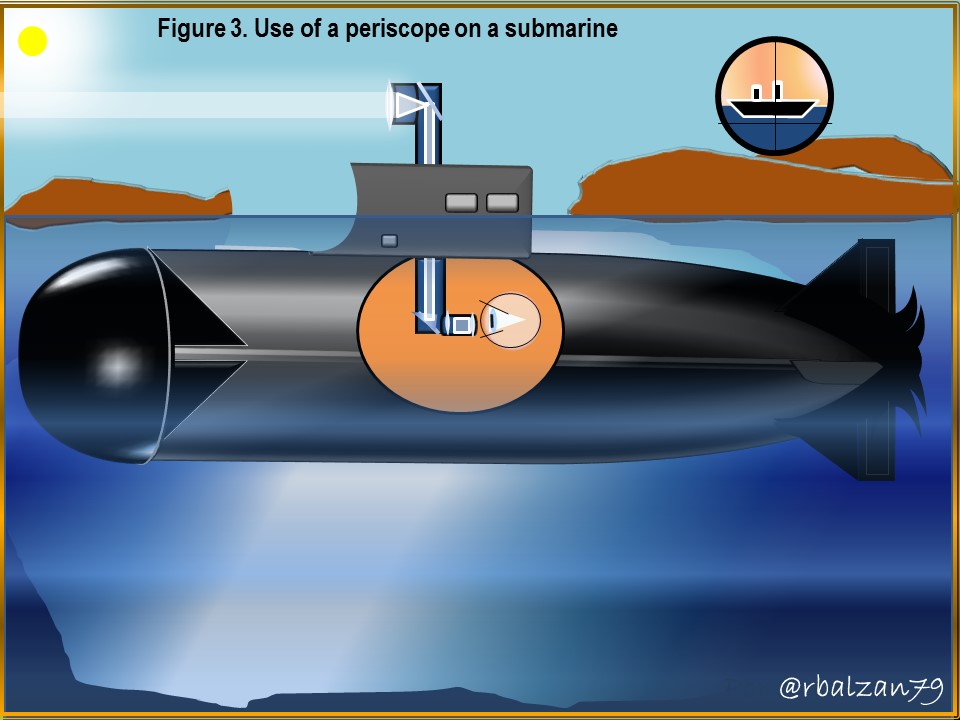
In the previous figure 3, we can see how useful this optical instrument is for this type of vessel, now, let's structure the optical system of a periscope in our way and, for this, we will select a convergent lens as objective, then two parallel flat mirrors at 45° and, in the ocular part of this device, we will place two convergent lenses as we can see in the following figure 4.
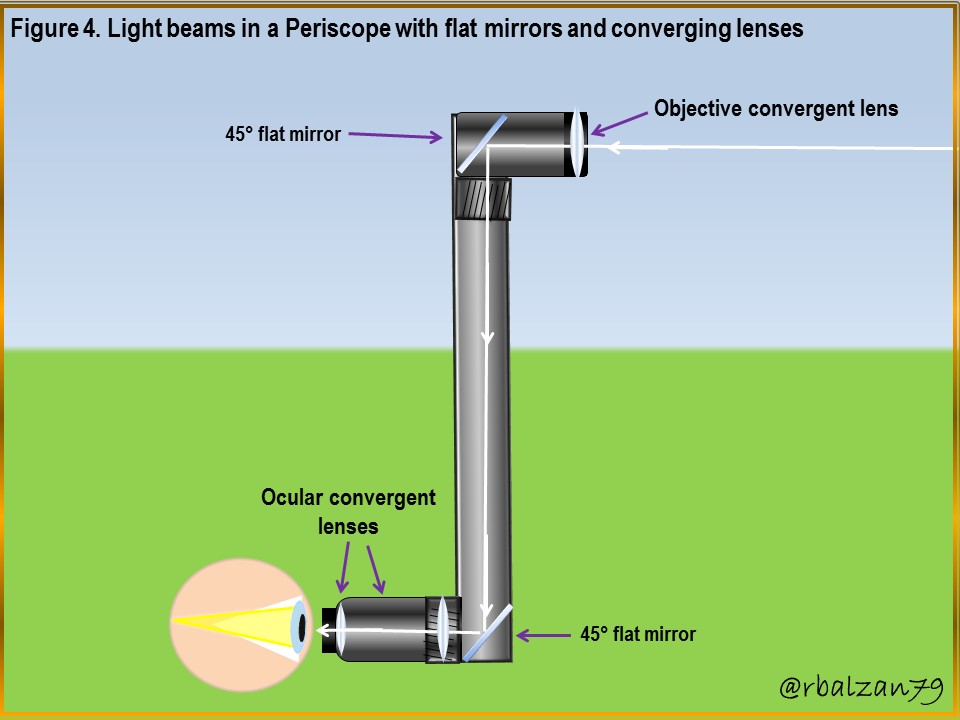
In the previous figure 4, we notice an optical system of a periscope much more complex than a traditional one, therefore, we will begin to analyze each of these optical elements in order to see the generation of the image of the object or body observed and how it reaches the retina of the person observing through this optical instrument, so let's start with the following analysis with the scheme of light rays that hit the convergent lens of the objective as you can see in the following figure 5.
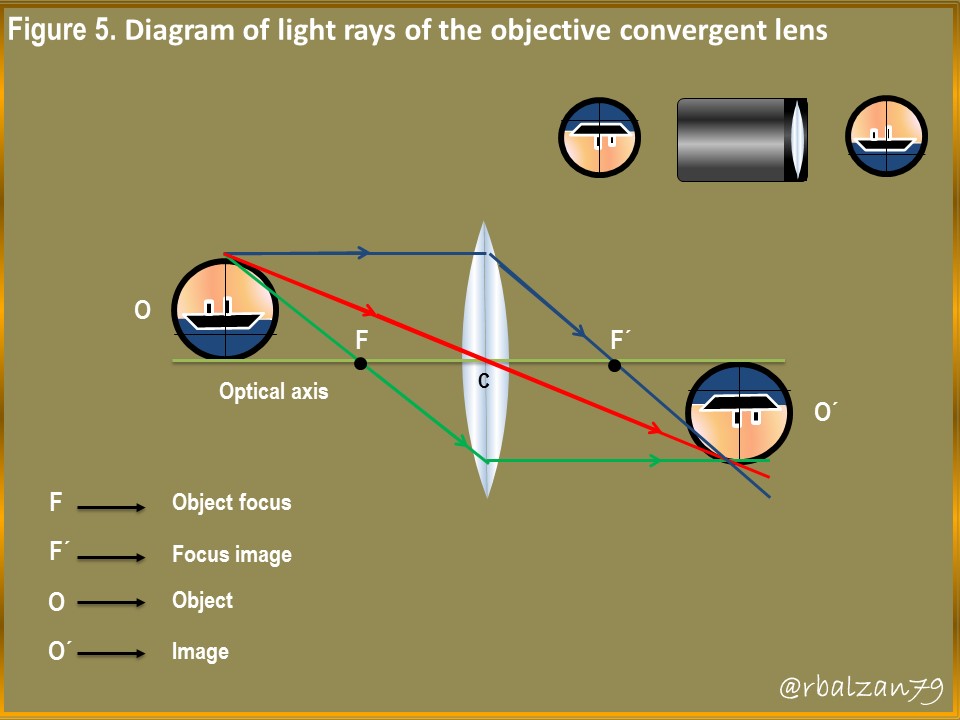
In the previous figure 5, we saw the characteristic behavior of this type of convergent lens, when flipping the generated image of an object that is at a greater distance than its focal length, thus generating a real image on the other side of the lens, from there, we move to the plane mirrors and, with this, we will see the scheme of light rays in these optical elements in the following figure 6.
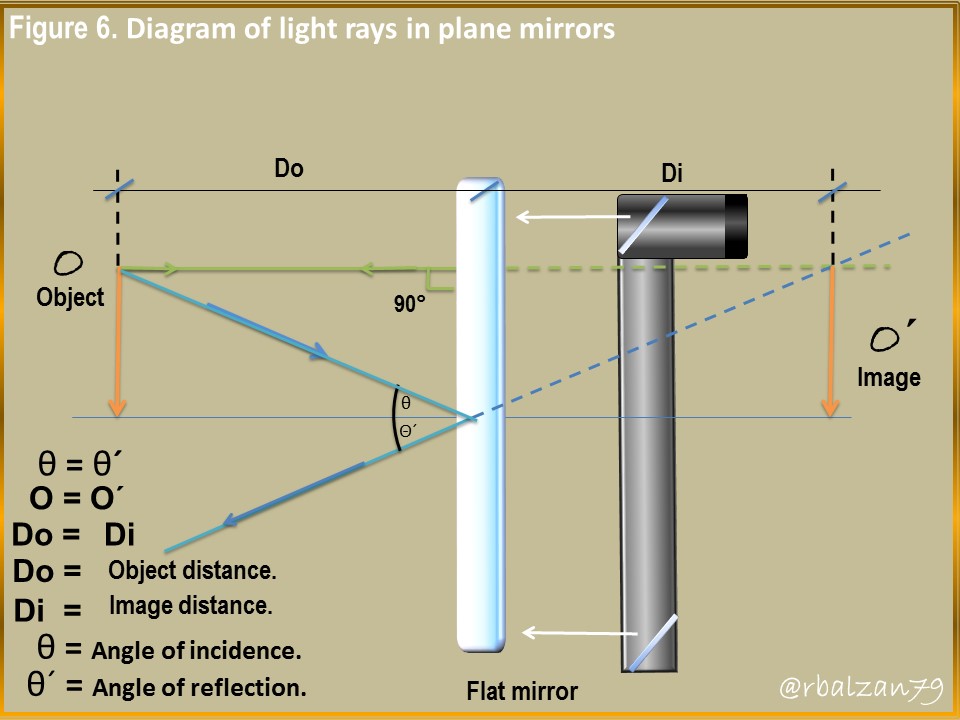
In the previous figure 6, we see how the light rays have been reflected on a flat reflective surface of each of the mirrors, following the law of reflection, in this case, the incident angles are equal to the reflected angles (θ = θ'), the image received by the first flat mirror, is an inverted image of the object, and as in lenses, the formation of images in plane mirrors could be analyzed with the implementation of two light rays, one coming from the upper end of the image (blue) to the center of the plane mirror reflected with the same angle of incidence.
Let us remember my dear readers that the images in flat mirrors will always be generated on the other side of where the object or body is, therefore, we must project each ray of incidence on the other side of the mirror, with another ray (green), which comes out parallel to the optical axis of the mirror and whose reflection was made on itself, this is because the angle of incidence is 90 ° as well as the angle of reflection.
When the projected lines intercept each other, our desired image is generated, whose characteristics will be: virtual image, the same size of the object and not inverted, in this way, the image will have the same characteristics with which it arrived at the first plane mirror, that is, inverse, in relation to the orientation of the analyzed object, the same happens with the next mirror and, in this way, the image will reach the lenses components of the ocular space of this optical instrument, in this case, two convergent lenses, so let's analyze the ray scheme in the following figure 7.

In this scheme of luminous rays, we clearly notice that the image in the first lens returns to the same orientation that the originally observed object has, that is to say, right, however, to guarantee that the image arrives inverted to the retina of the person who observes, we must make this image pass through another convergent lens and, This is in order for the image to be real, to be generalized on the other side of the lens and, above all, to be inverted, since in this way it will reach the observer's retina, as can be seen in the figure above.
Conclusion
Another great and wonderful optical instrument designed with the purpose of being able to perform excellent tasks of visualizations of objects or bodies from a hidden space and, where our eyes can not reach directly or, we can not do it for some strategy, or by having many people in front of us, the truth is that, by combining these impressive optical elements we have been able to perform countless tasks or activities in the best possible way, thanks to the understanding of the essential phenomenon of light.
This is an instrument that we can make at home and, for example, the traditional periscope with optical elements of a pair of flat mirrors, in this way we can teach children the importance of light in our lives, but, also, through time this wonderful instrument has been modified and improved thanks to the implementation of a complex optical system, where the eyepiece can be represented by a binocular with all its corresponding elements.
The path of the luminous rays through each of the component elements of this optical instrument, composed in this case, by a convergent lens as objective, a pair of flat mirrors and two convergent lenses in the ocular part in charge of taking the final image to the observer's retina, was wonderful, as could be seen in each of the light ray diagrams analyzed.
Until another opportunity my dear friends.
Note: The images were created by the author using Power Point and Paint, the animated gif using PhotoScape.
Recommended bibliographic references
[1] GEOMETRIC OPTICS. Link.
[2] Convergent lenses. Link..
[3] Periscope. Link..
[4] Images in Planemirrors. Link.
This made me to remember my physics course
Thank you for your valuable visit and for your comment, physics is always impregnated in our memory and when something reminds us of it, these wonderful memories come to the surface. Greetings.
Thanks for your contribution to the STEMsocial community. Feel free to join us on discord to get to know the rest of us!
Please consider delegating to the @stemsocial account (85% of the curation rewards are returned).
You may also include @stemsocial as a beneficiary of the rewards of this post to get a stronger support.